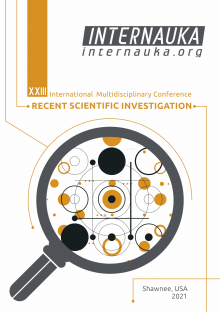THE USE OF TECHNOLOGY IN SPECIAL EDUCATION

THE USE OF TECHNOLOGY IN SPECIAL EDUCATION
Arina Budyakova
Graduate, Belgorod State University,
Russia, Belgorod
Currently, technology plays a pivotal role in our daily grind. Not only has the technology become the standard of every aspect of our lives but also its popularity is changing at dizzying speed.
While students used to carry a pile of textbooks to school, now they’re used to carrying laptops—even at the elementary level. Technology has always been created to make the user’s tasks easier to complete, whether it’s an assignment for a class, a time-sensitive project for an employer, or annual tax documents. For students with developmental and learning disabilities, the need for technological assistance in education is even more crucial.
Special education is geared toward students living with a broad range of conditions, including blindness, attention deficit/hyperactivity disorder (ADHD), Down syndrome, motor impairments, and autism. individuals with specific learning disabilities or speech or language impairments make up the majority of these students. Technology in special education can help these disabled students keep up with their peers to the extent possible and prepare for future success.
In 2019–20, the number of students ages 3–21 who received special education services under the Individuals with Disabilities Education Act (IDEA) was 7.3 million, or 14 percent of all public school students. Among students receiving special education services, the most common category of disability (33 percent) was specific learning disabilities. [2].
The educational standards claim that students with disabilities should be provided with opportunities to realize their potential. They should participate in education and training on the same basis as students without disabilities and that they are not subject to discrimination. Due to the progress in the IT industry, digital technologies are easily accessible and widespread which allows using them for providing students with new opportunities.
There can’t be a single technological solution that would suit the needs of all students with special needs. Due to the high diversity of types of disabilities, the best possible outcome can be guaranteed by the use of custom-made solutions designed according to the requirements of a particular group of students.
According to the National Center For Education Statistics, in 2015–2016, the number of students served under the Individuals with Disabilities Education Act (IDEA) in the US was 6.7 million. This number is equal to 13% of all public school students. While the percentage of such students stays pretty much the same during the last years, the total number of them has increased by 0.3 million since 2011-2012. The percentage distribution of different disabilities types is presented in the National Center For Education Statistics website.
These numbers tell us that there can’t be a single technological solution that would suit the needs of all students with special needs. Due to the high diversity of types of disabilities, the best possible outcome can be guaranteed by the use of custom-made solutions designed according to the requirements of a particular group of students.
Special technology allows increasing the independence of a particular student freeing him from the constant need for direct teacher involvement. As a result, a student can choose the speed of learning that is convenient for him which leads to more personalized learning. When a student doesn’t inhibit the learning process for the whole group, it allows reducing the anxiety level which plays a significant role in education as well. Implementation of technologies in special education allows simplifying the communication and improve the academic skills of students with disabilities.
Table 1.
Assistive technology

There are many ways of how technology can help students with special needs. For example, some kinds of disabilities don’t allow students to use handwritten text that is an integral part of "traditional" education. Using technical tools intended for human speech recognition and synthesizing, you can avoid the necessity to use paper and pen during the lessons. Such technology would be also helpful for students with disorders that don’t allow to process visual information correctly.
The adaptive computing technology allows using digital devices to bypass challenging tasks. Screen reader applications such as JAWS along with specially designed Braille keyboards allow visually challenged students to use the computer.
Augmentative communication systems help students with speech problems to overcome the communication barrier.
Such systems use picture charts, books, and specialized computers providing functions of word-prediction for more effective communication.
Before applying for services of a company that develops technologies for special education, consider the following advice:
- Pay attention to the cost of a given solution and its potential effect on the learning process.
- Prefer a technology that is not difficult to master.
- Make sure that the application you’re going to choose is reliable and will naturally integrate into the educational process.
- Focus on user-friendly and intuitive solutions.
- Possibility to implement custom functionality that meets your requirements or customize the existing solution.
The use of technology in special education helps break the barriers and broaden the horizons for people with disabilities and provide them with access to the most relevant educational programs. Properly designed software and hardware allow students with special needs to get modern education and achieve any required information online.
Technology helps provide students with individual learning events, enables reaching higher flexibility and differentiation in educational methodologies. With modern technology, teachers can adapt to the possibilities of a particular student with minimum effort and choose one of the dozens of available learning tactics designed to meet the needs of individual learners.
References:
- Electronic resource: https://nces.ed.gov/programs/coe/indicator_cgg.asp
- Electronic resource: https://www.iste.org/explore/Innovator-solutions/How-special-education-technology-improves-learning
- Electronic resource: https://elearningindustry.com/use-of-technology-in-special-education
